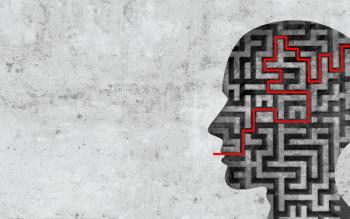
Marsha Linehan: Dialectic Behavioral Therapy
For her work in establishing the Dialectic Behavioral Therapy (DBT) model for use with chronically suicidal individuals suffering from borderline personality disorder (BPD), Marsha M. Linehan, Ph.D., is this year's recipient of the annual research award given by the New York City-based American Foundation for Suicide Prevention (AFSP).
July 1999, Vol. XVI, Issue 7
For her work in establishing the Dialectic Behavioral Therapy (DBT) model for use with chronically suicidal individuals suffering from borderline personality disorder (BPD), Marsha M. Linehan, Ph.D., is this year's recipient of the annual research award given by the New York City-based American Foundation for Suicide Prevention (AFSP). Linehan is professor of psychology and adjunct professor of psychiatry and behavioral sciences at the University of Washington.
Before receiving her award, Linehan-who is also director of the Behavioral Research and Therapy Clinics, a federally funded program that evaluates the efficacy of treatments for suicidal behavior, substance abuse and BPD-gave a lecture about her work. "I'm going to talk about how to create a life worth living," she told attendees. "How do you change the brain is the fundamental question of the day, especially in people who through their learning, trauma or intrauterine experiences end up with brains that create a life that is perceived as painful and not worth living."
Linehan noted that suicide has "been with us a long time" and that "all our drugs and treatments have not made a dent" in suicide rates. And, despite the fact that suicide is among the top 10 causes of death, there have been fewer than 25 randomized controlled trials of any treatment-biological or psychological-designed specifically for reducing risk of suicide among patients already identified as suicidal. Instead, she said, most treatment studies that examine characteristics associated with suicide exclude high-risk individuals.
Linehan noted that the Finnish National Suicide Project (Henriksson et al., 1993), which conducted psychiatric autopsies of suicides, indicated that depression accounted for 28% to 59% of suicides, whereas personality disorders accounted for 35% to 45%. "That's a stunning number," said Linehan, adding that an even higher percentage of those attempting suicide have a personality disorder and that BPD is the personality disorder most associated with both attempted and completed suicides.
"The basic idea is that BPD is a pervasive disorder of the emotion regulation system," she said. "BPD criterion behaviors function to regulate emotions or are a natural consequence of emotion dysregulation. From that point of view, suicide is a very powerful regulator, and nonfatal suicidal behavior is extremely effective in regulating emotions. For BPD patients, suicide is often the only effective behavior."
As a treatment-researcher, Linehan said her research began with the question "Why not commit suicide?" "The idea was to figure that out and then teach people who want to do it how not to want to," she explained. In the early 1980s, she developed the Reasons for Living Inventory (Linehan et al., 1983), listing six basic reasons people have for staying alive when thinking about suicide. According to Linehan, these include survival and coping beliefs, such as "life will get better," "I can cope" and "life has value," responsibility to family, concerns for children, fear of the act of suicide, fear of social disapproval of suicide and moral concerns about suicide. "I see a lot of people [with BPD] who don't have these things to hold on to," she said. "Fifty percent to 75% make a suicide attempt sometime."
With borderline patients in mind, Linehan developed DBT as a comprehensive psychosocial treatment program that blends together the most effective interventions in behavior therapy and balances them with treatment strategies that focus on acceptance and validation. "It is currently the only psychotherapy that has been shown to be effective in a randomized trial for BPD," said Linehan. "The emphasis on dialectics focuses treatment efforts on identifying and resolving the inherent tensions that both demand as well as impede change. The overriding dialectic is the necessity of acceptance of patients as they are within the context of moving them to change."
DBT occurs in four stages. In the first stage, the focus is to get behavioral control. "Out-of-control behaviors constitute those that are disordered due to the severity of the disorder or resulting from having multiple diagnoses, such as the suicidal borderline patient with co-morbid panic disorder and depression," said Linehan. "[The focus here] is on keeping the patient alive and in the treatment setting, and gaining required skills and quality of life necessary to work on any further goals."
In the second stage, the treatment goal is to replace "quiet desperation" with the ability to experience both positive and negative emotions without being traumatized by the experience. In the third stage, the goal is to achieve "ordinary" happiness and unhappiness, and reduce ongoing disorders and problems in living. The fourth and final stage focuses on resolving the patient's sense of incompleteness and achieving capacity for joy.
"In sum, the orientation of DBT is to first get action under control, then to help the patient feel better, to resolve problems in living and residual disorder, and to find joy and, for some, a sense of transcendence," explained Linehan. "All my research is at level one, but you can't stop treatment there. If you don't go to the next levels, [patients] will often move back to level one again."
Treatment at each level is very different. Level one is behavioral therapy that decreases behaviors that are life-threatening or interfere with therapy and quality of life, while increasing behavioral skills of mindfulness, interpersonal effectiveness, emotion regulation, distress tolerance and self-management. Level two involves exposure-based procedures. Level three utilizes a range of interventions, and level four involves treatments such as spiritual counseling, existential analysis or "any work with a wise person," Linehan said.
The milieu for DBT is outpatient, and patients get group skills training and telephone consultation, said Linehan. "The comprehensiveness of the intervention addresses five basic functions: enhancement of patient capabilities, improvement of motivation, assurance of generalization of new skills and motivation to the natural environment, structuring the immediate environment to reinforce skillful functioning rather than problematic functioning, and enhancement of [the] therapists' capabilities and motivation to treat patients effectively," she explained.
Linehan emphasized that DBT therapy stresses acceptance, not judgment, of the patient. "Applying treatment strategies is a dance between acceptance and change," she said.
Regarding clinical research on DBT, Linehan said her first randomized clinical trial (Linehan et al., 1991) evaluated a comprehensive DBT package consisting of weekly individual therapy and group skills training. Compared to community-based treatment-as-usual (TAU), DBT subjects were less likely to attempt suicide during the treatment year, reported fewer suicide attempts at each assessment point, and had less medically severe suicide attempts over the year. DBT was also more effective at limiting treatment dropout and reducing inpatient psychiatric days. Also, at the end of treatment, DBT patients functioned better and were more improved on a number of characteristics associated with BPD, such as anger. DBT superiority was largely maintained during the one-year posttreatment follow-up period.
Since that first trial, three other groups have conducted their own trials to evaluate DBT compared to TAU. In a study of 20 patients (Koons et al., 1998), researchers at Duke University and the U.S. Department of Veteran's Affairs Hospital in Durham, N.C., found that women with BPD in the VA system who were assigned to DBT had greater reductions in deliberate self-injury and suicide attempts taken together, and in depression, than those assigned to TAU. Also, those assigned to DBT had significant improvements in suicide ideation, hopelessness, anger, hostility and disassociation.
In a study (Miller et al., 1997) that applied an adaptation of DBT for suicidal adolescents, researchers reported greater reductions in psychiatric inpatient days as well as treatment dropout for those receiving DBT versus TAU. At Columbia University, researchers (Stanley et al., 1998) looked at suicidal patients with BPD and found that those in DBT had greater reductions in self-mutilation acts, suicide ideation, suicidal urges and urges to self-mutilate than did matched subjects in TAU.
"In general, results have largely replicated the initial randomized controlled trial," said Linehan. She said that current research is underway by 10 groups of investigators to adapt DBT to other disorders and for other difficult-to-treat patient populations including opiate-dependent individuals with HIV, opiate- and methamphetamine-dependent women with BPD, inmates with antisocial personality disorder and binge-eaters.
Linehan said her own group is now halfway through a replication trial comparing DBT to community-provided "treatment by experts." This trial is funded by the National Institute of Mental Health. For this study, control-condition therapists were nominated by local therapists for their expertise in treating suicidal and/or BPD patients and asked to apply the best standard of care, including any medications viewed as appropriate and necessary. "This treatment-by-experts condition rigorously controls for many aspects of the DBT treatment, making it a robust condition in which to evaluate DBT," said Linehan. "We are also interested in what factors besides treatment orientation are important for outcome. Results are not yet available."
She and her colleagues have also been looking at DBT for the treatment of drug abuse. "In a first study [Linehan, 1997] of 28 substance abusers, we compared an adaptation of DBT to TAU and found that subjects assigned to DBT had greater reductions in illicit substance use both during treatment and at follow-up, and greater improvements in global functioning and social adjustment at follow-up," she reported.
If behavioral treatments change behaviors correlated with biological systems, then they may also be changing the associated biological systems. "Change the behavior, and you'll change the brain," Linehan said.
References
Henriksson MM, Aro HM, Marttunen MJ et al. (1993), Mental disorders and comorbidity in suicide. Am J Psychiatry 150(6):935-940.
Koons CR, Robins CJ, Bishop GK et al. (1998), Efficacy of dialectical behavior therapy with borderline women veterans: a randomized controlled trial. Paper presented at 32nd annual convention of the Association for the Advancement of Behavior Therapy. Washington, D.C.
Linehan MM (1997), Self-verification and drug abusers: implications for treatment. Psychological Science 8:1-3.
Linehan MM, Armstrong HE, Suarez A et al. (1991), Cognitive-behavioral treatment of chronically parasuicidal borderline patients. Arch Gen Psychiatry 48(12):1060-1064. See comments in 50(2):157-158.
Linehan MM, Goodstein JL, Nielsen SL, Chiles JA (1983), Reasons for staying alive when you're thinking of killing yourself: the reasons for living inventory. J Consult Clin Psychol 51(2):276-286.
Miller A, Rathus JH, Linehan MM et al. (1997), Dialectical behavior therapy adapted for suicidal adolescents. Journal of Practical Psychiatry and Behavioral Health 3:78-86.
Stanley B, Ivanoff A, Brodsky B, Oppenheim S (1998), Comparison of DBT and "treatment as usual" in suicidal and self-mutilating behavior. Paper presented at 32nd annual convention of the Association for the Advancement of Behavior Therapy. Washington, D.C.
Newsletter
Receive trusted psychiatric news, expert analysis, and clinical insights — subscribe today to support your practice and your patients.















